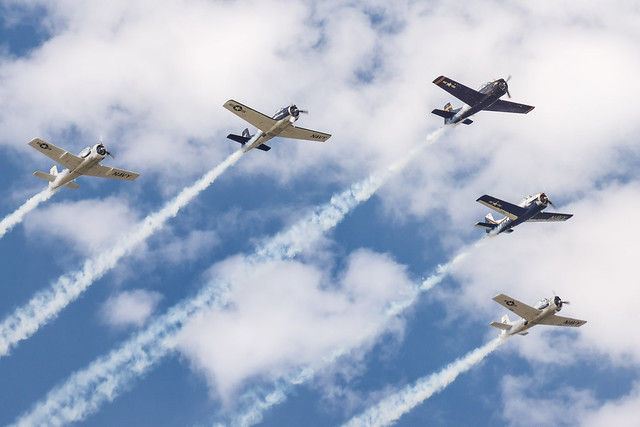Fighter
The Flight Brothers

A beautiful historical display – these two venerated ,war birds flew together through the blue skies over Oshkosh, Wisconsin during an airshow at the EAA AirVenture 2019. The upper plane is “Quick Silver, a P-51D, Mustang. The lower plane is a Chance-Vought F4U-4 Corsair.
One of the aspects of AirVenture I appreciate most is their emphasis on honoring our veterans and the hardware our true heroes used to protect and serve. Both of these were used to protect and secure the freedom of others. You can learn more about these vintage war planes through their respective websites – Quick Silver P-51D MUstang and Chance-Vought F4U-4 Corsair.
You can view a larger, more detailed version of this image by clicking on the photo.
All of the photos I post are available for purchase. If you’d like to buy one, click on the blue “Buy this Online” bar below for a variety of print and frame options or contact me for digital purchase and licensing options.
High Flying Five

These vintage Navy planes were part of the air show at this year’s E.A.A. AirVenture in Oshkosh, WI. I think it would be very cool to fly with a group like this.
I’m not positive about the type of aircraft, but I think some might be the North American SNJ-4, an advanced trainer for WWII aviators. (It was also called the T-6, the AT-6, and the Texan.)
To get better view, click on the image and a larger version will open in a new browser tab.
Zeros

Three vintage fighter planes circle back for another simulated strike during a reenactment of the attack on Pear Harbor. This was part of a spectacular air show at the 2013 EAA AirVenture in Oshkosh, Wisconsin.
Though I’ve had little opportunity, I could really get into aviation photography. I am not a pilot, but I love to fly and love all type of aircraft.
These planes are Japanese Zeros. Here’s some info gleaned from Wikipedia…
The Mitsubishi A6M Zero was a long-range fighter aircraft operated by the Imperial Japanese Navy from 1940 to 1945. The A6M was usually referred to by the Allies as the “Zero”, from 1940, the year in which the aircraft entered service with the Imperial Navy. The official Allied reporting name was “Zeke”.
When it was introduced early in World War II, the Zero was considered the most capable carrier-based fighter in the world, combining excellent maneuverability and very long range. In early combat operations, the Zero gained a legendary reputation as a dogfighter, achieving the outstanding kill ratio of 12 to 1, but by mid-1942 a combination of new tactics and the introduction of better equipment enabled the Allied pilots to engage the Zero on more equal terms.
To view a larger version of this image, click on it.


















































